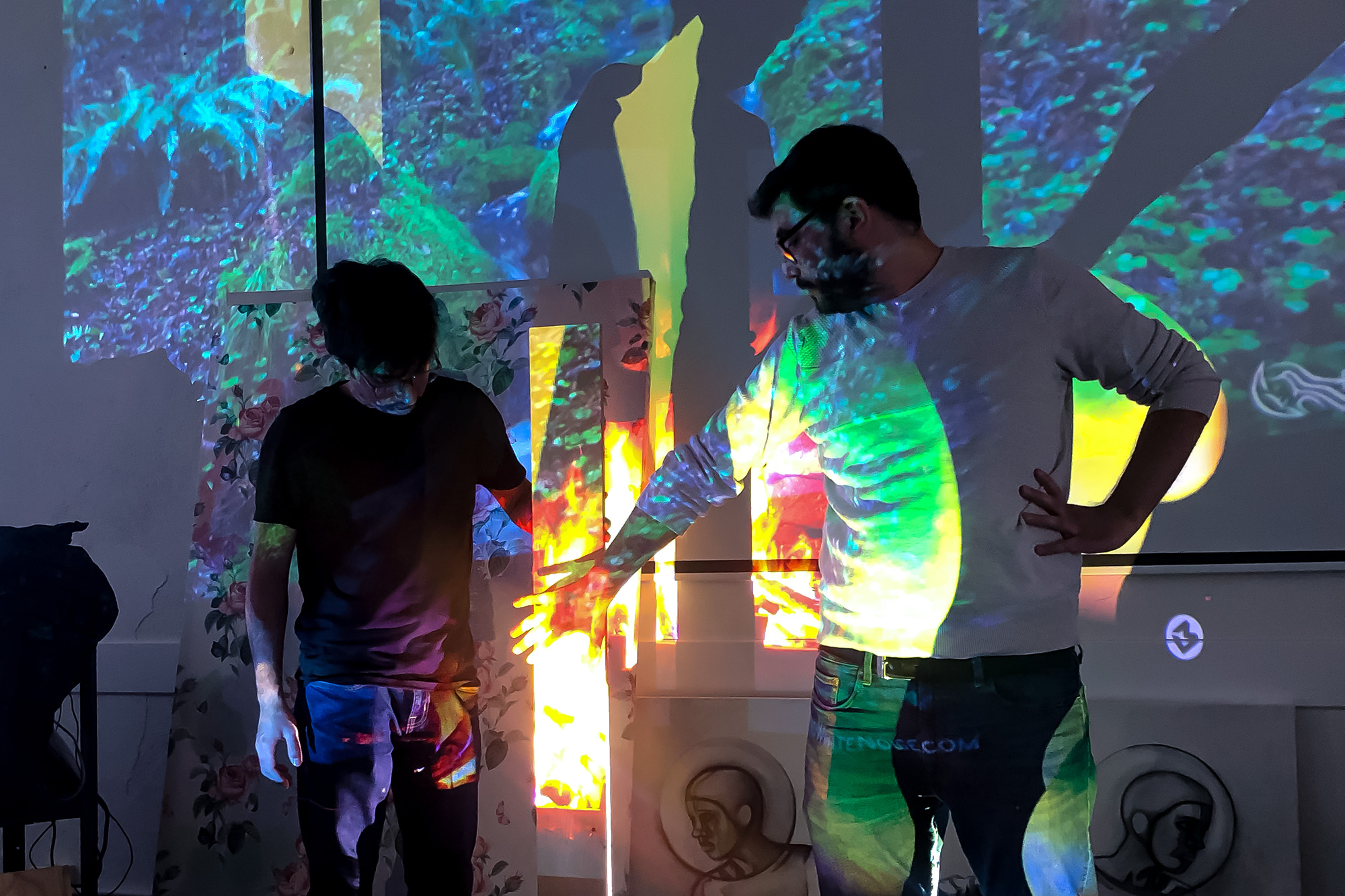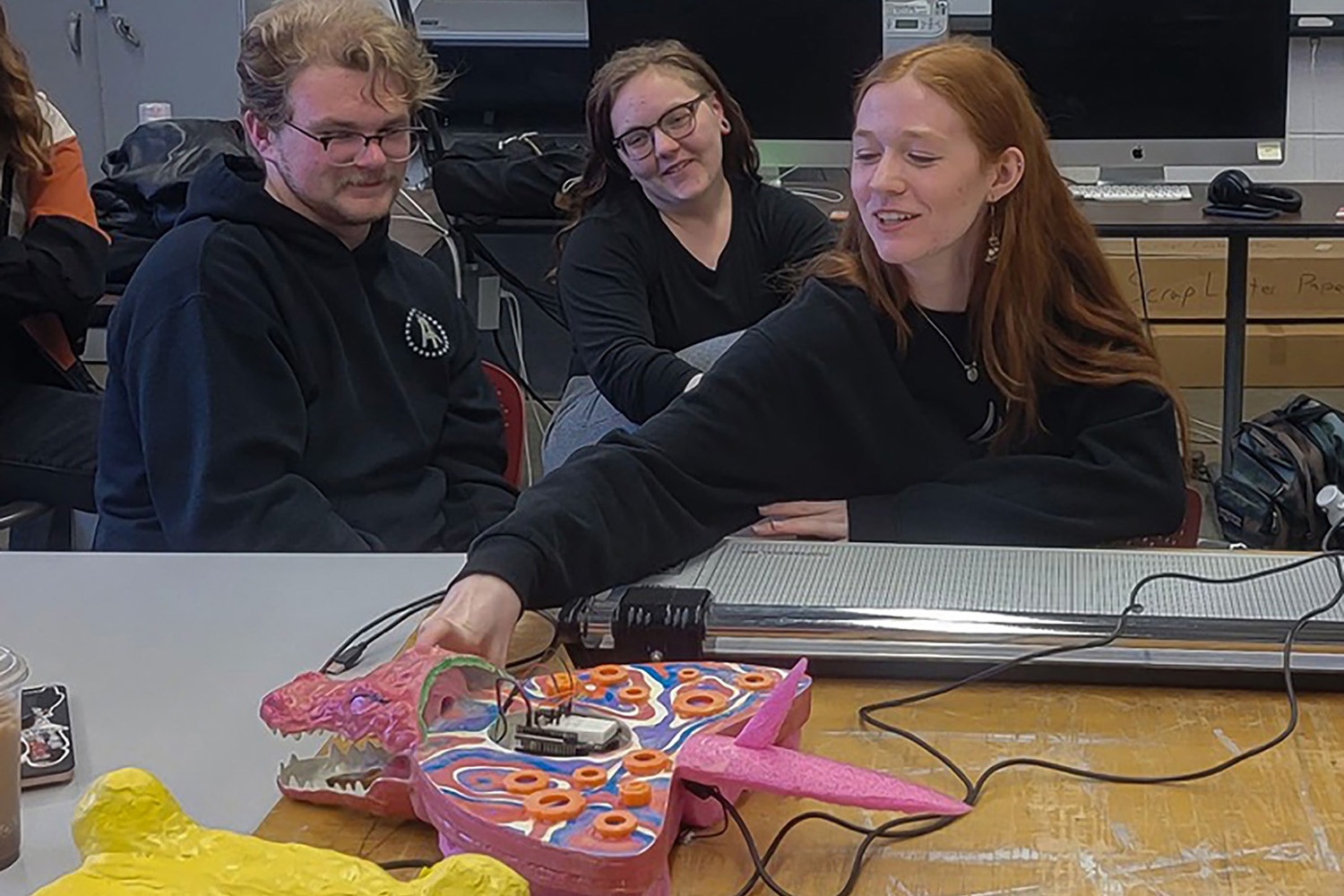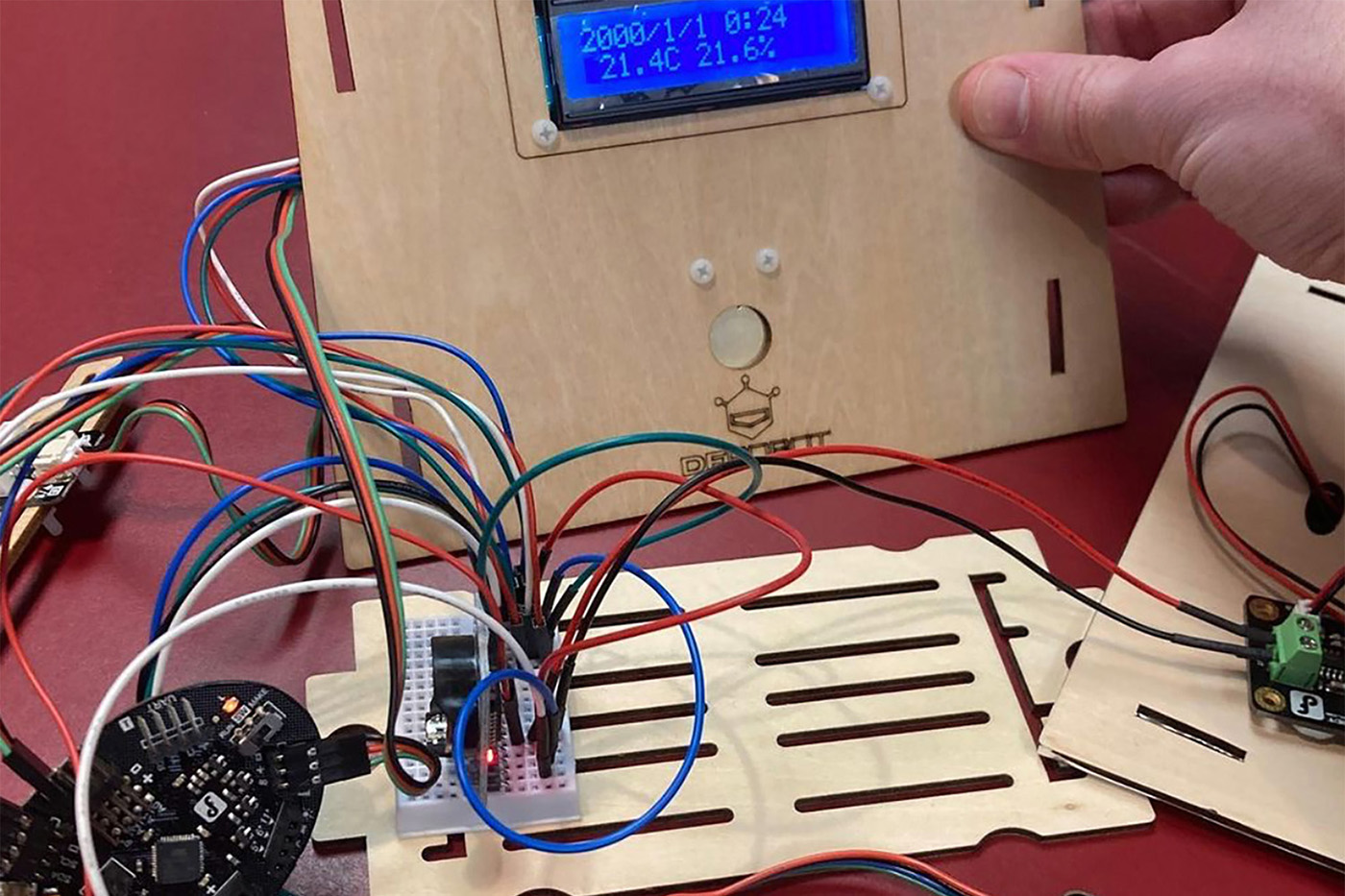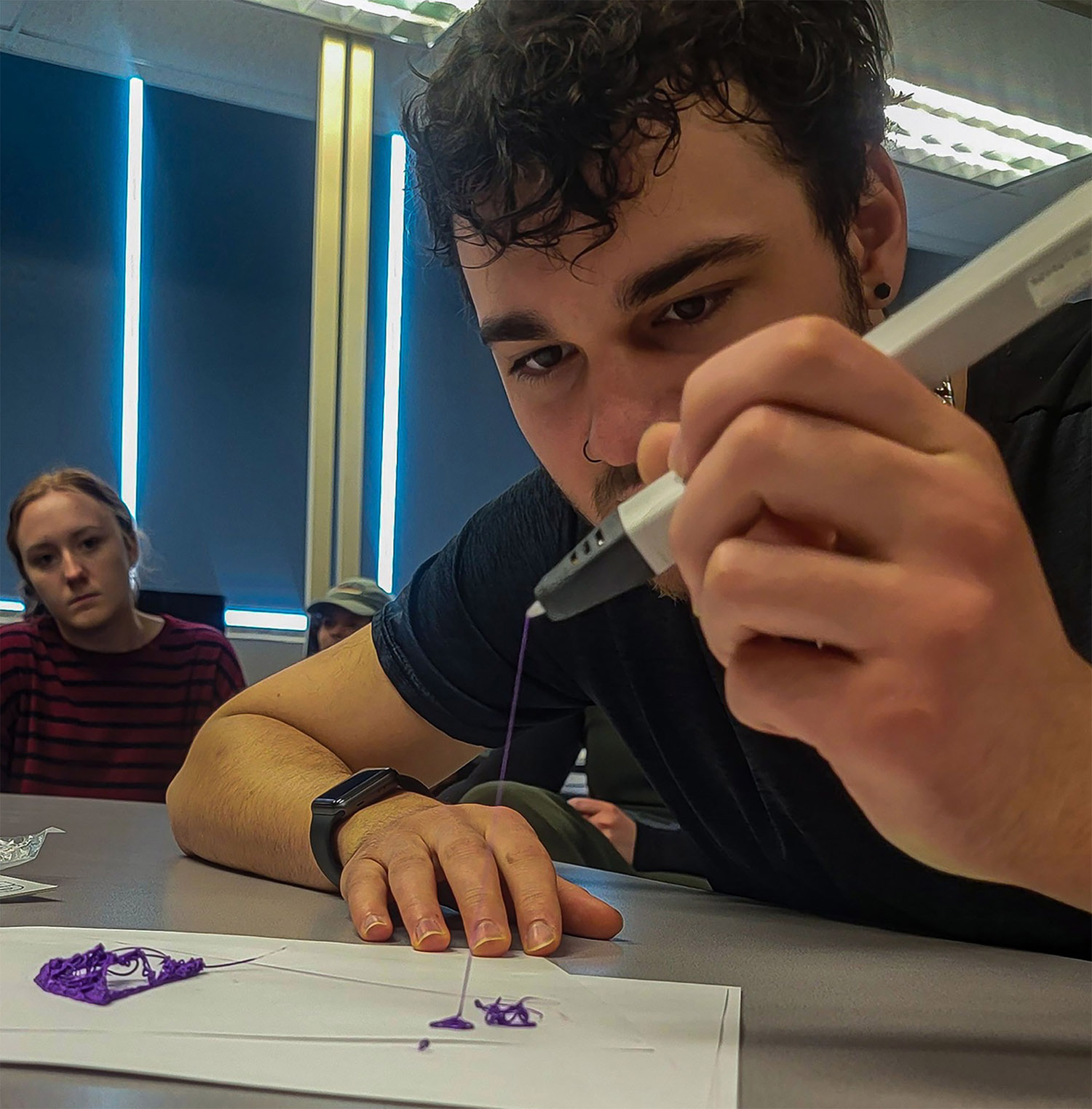

The intersection of art and technology: OHIO’s Digital Art + Technology program
Ohio University's Digital Art + Technology program blends creative vision with technology, offering hands-on courses in digital art, fabrication, and coding, preparing students for diverse careers in the digital art field.
June 24, 2024
Share:
Technology is constantly reshaping our world, opening up exciting new possibilities for artistic expression and audience interaction.
“The more technology advances, the more tools artists have to explore, create, and express their artistic concepts,” said Assistant Professor of Instruction, Digital Art + Technology Basil Masri Zada.
This forward-looking mindset is the inspiration behind OHIO’s Digital Art + Technology (DAT) concentration program, designed to help aspiring artists merge their creative vision with technological innovation.
A foundation in digital art creation
Offered through the College of Fine Arts School of Art + Design, the DAT concentration prioritizes hands-on learning experiences. Students delve into the world of digital art creation, fabrication, and coding, acquiring skills in industry-standard tools and techniques.
This foundation begins with core courses in digital drawing, painting, and 2D animation, nurturing each student's unique artistic voice. It's then bolstered by specialized courses in digital fabrication and creative coding, equipping them with practical tools like laser and CNC etching, 3D printing, and advanced programming languages. By mastering these skills, students gain the power to translate their artistic concepts into tangible creations.
Who should consider a digital art degree program?
Because of its wide range of applications, a digital art degree program can be a perfect fit for anyone with an interest in computers, gaming, animation, circuitry, interactivity, social practices, installation art, media arts, video arts, digital experiences, and even light and shadow manipulation. Anyone with an interest in digital painting, sculpting, or any of these areas, should consider earning a degree in digital art.

Creative Coding for Artists I, students presenting their In-Habitant projects with the Arduino circuitry and technology.
Software and technologies at the core
The DAT curriculum integrates a wide range of industry-standard software and technologies to provide students with a well-rounded skillset. This includes:
Adobe Creative Cloud Suite (including most 3D modeling programs)
Blender
Unreal Engine
Processing for creative coding
Cura and Bambu Labs for 3D printing
LightBurn for Laser cutting
Remote supercomputing access for high-powered digital programs
Procreate and SketchUp for digital drawing and painting
Visual coding programs and applications
Artificial intelligence and generative processes (AI)
What role will AI play in the future of art?
“AI's role is becoming a reality in Art whether we want that or not. I believe that understanding AI and being one of the first researchers and adapters to its uses in studio art practice helps us utilize it better without compromising creative authenticity,” said Masri Zada. “AI-powered tools are not new; what is new is a technology revolution that made it more popularized for art, we want our students to understand the pluses and minuses of this technology and create a safe and ethical environment for them to explore it.”
To this end, the DAT program integrates AI into the curriculum in a way that maintains creative integrity while equipping students to navigate and leverage it responsibly.
“In our approach to the curriculum, we introduce students to AI and its research and practices in art, ethical issues, and productivity tools that use AI, and we train them on how they can utilize it as a tool, not as purpose.”
A look inside the DAT curriculum
All first-year students in the School of Art + Design begin with Foundations Program alongside other first-year BFA Studio Art students before pursuing a concentration in Digital Art + Technology.
- ART 2110: Digital Art + Technology I - This introductory course delves into essential techniques, technologies, and tools for crafting digital artwork in today's context, highlighting how artists employ digital imaging for creative expression. Students participate in discussions and evaluations to cultivate their individual approaches to digital and physical creations.
- ART 3110: Digital Art + Technology II - This advanced studio course builds on ART 2110, with a focus on incorporating digital techniques to craft visually engaging compositions. Students will have the chance to explore various presentation methods, engage in critical analysis, and experiment with innovative digital art forms.
- ART 2120: Creative Coding for Artists I - Introducing students to creative coding for artists, this course emphasizes the technologies and methodologies essential for creating digital art compositions. Students will gain hands-on experience in using code and various technologies across static or interactive mediums in 2D, 3D, and time-based formats. Students will explore "data art" and experiment with drawing using code and robotics.
- ART 3120: Creative Coding II - This advanced studio course encourages students to broaden their artistic horizons through exploring digital art, computed creations, physical computing, and technological experimentation. It provides students with the skills to create both static and interactive works across a range of mediums.

Creative Coding for Artists I, Arduino circuits, coding, and demonstration for students.
A program designed for the future
The program recognizes the ever-evolving nature of digital art and multiple technological applications.
To ensure this, program faculty actively participate in ongoing research to keep the curriculum up to date with the latest practices in the ever-evolving technological landscape. Regular updates, workshops, and student experiences ensure the program remains at the forefront of innovation. Collaborations with industry experts from companies like Ohio Supercomputer and IBM provide students with access to cutting-edge technology, preparing them to excel as leaders in the field.
“Artists have always been early adapters of technologies and have worked side by side with technology partners, initiatives, and scientists to create unique experiences and art practices,” said Masri Zada. “This is part of our goal to keep expanding our partnerships to encourage our digital art and technology students to push boundaries and connect them and have them experience many new technologies, workshops, partnerships, and external experiential learning opportunities to help them push boundaries and explore uncharted territories of art that utilize such technologies with a contemporary studio art practice.”
Balancing artistic vision with technical expertise
The DAT concentration balances the development of foundational art skills with acquiring digital and technological expertise. Courses emphasize experimentation, with plenty of tutorials, workshops, and demos to introduce students to new mediums, technologies, and experiences. Each student's unique artistic background is integrated with their newly acquired technical skills, allowing them to build strong studio art concepts that can be presented as part of their contemporary art practice in physical spaces.
A hub of innovation and collaboration
The digital arts degree program provides students with access to a range of specialized facilities and equipment to support their creative endeavors. This includes:
High-Performance Computing: Students have access to two remote supercomputers that offer exceptional processing power for demanding applications and the program's dedicated AI programs.
Studio Space: Students have access to dedicated studio spaces for both group and individual work, providing opportunities to further their creative explorations beyond class time.
Digital Fabrication Lab: The program features a well-equipped digital fabrication lab featuring a large laser cutter, several smaller laser cutters, an upcoming CNC machine, multiple 3D printers, and vinyl cutters.
Emerging Technologies: Students have access to a continually expanding collection of cutting-edge technologies, including VR and AR equipment, Arduino circuitry boards, various controllers, projectors, high-performance computers, and more.
Additional Resources: To ensure students have a solid foundation, the DAT program partners with various resources on campus in Athens, such as the CREATE_Space in the College of Fine Arts and the CoLab in the Vernon R. Alden library. These collaborations, combined with hands-on learning opportunities and workshops, offer students a comprehensive support network.

Digital Art + Technology, students experimenting with 3D Printing Pens as part of the digital fabrication demonstration.
What can you do with a digital arts degree?
Graduates of the DAT program will earn Bachelor of Fine Arts degree, opening doors to a diverse range of possible career paths.
Digital artist: This diverse field includes artists who utilize digital tools and technologies to craft illustrations, animations, concept art, and more for various purposes.
Interactive media artist: This position involves crafting interactive artwork that directly engages the audience. Graduates of the DAT program can leverage skills in coding and fabrication to create immersive installations, performances, and other interactive experiences.
3D modeler/animator: Graduates can use their 3D printing and modeling skills to create models for animation, video games, or other digital applications.
Motion graphics artist: This career involves creating animated graphics for use in videos, presentations, advertisements, and other media. The expertise that DAT graduates bring in coding and visual design makes them ideal candidates for thriving in this dynamic field.
UX/UI designer: User Experience (UX) and User Interface (UI) designers focus on creating user-friendly and visually appealing interfaces for websites, apps, and other digital products. An understanding of design principles and talent for translating artistic visions into digital experiences are well-equipped to excel in these positions.
Virtual reality (VR) or augmented reality (AR) content creator: The VR/AR industry is rapidly growing, and those with skills using digital tools and technologies can create immersive experiences for entertainment, education, and other applications.
Projection artist: This role involves using projectors to create large-scale artwork on buildings, landscapes, or provide engaging backdrops for theatrical performances. Graduates of the DAT program can utilize their expertise in lighting, technology, and visual design to thrive in this dynamic and engaging field.
Art educator with a focus on digital art: Graduates can share their passion and knowledge by teaching digital art skills to students of all ages in schools, community centers, or private studios.
Freelance multimedia artist: This entrepreneurial career path relies on using a diverse skillset to work on a variety of freelance projects, creating digital artwork, designing websites, or developing interactive experiences for clients across different industries.
Continuing your education journey is another option
Many students choose to further their education by pursuing a Master of Fine Arts (MFA) or a graduate degree in digital art, computer art, creative coding, or multimedia design.
Master of Arts Administration
Master of Arts in Arts History
MFA in Photography & Integrated Media
MFA in Painting & Drawing
Explore the cutting edge of digital art at OHIO
Ohio University's Digital Art + Technology concentration program prepares students with the skills to seamlessly blend art and technology, empowering them to make a positive impact on the world. Ready to explore your creative potential? Learn more about the OHIO’s program today!


